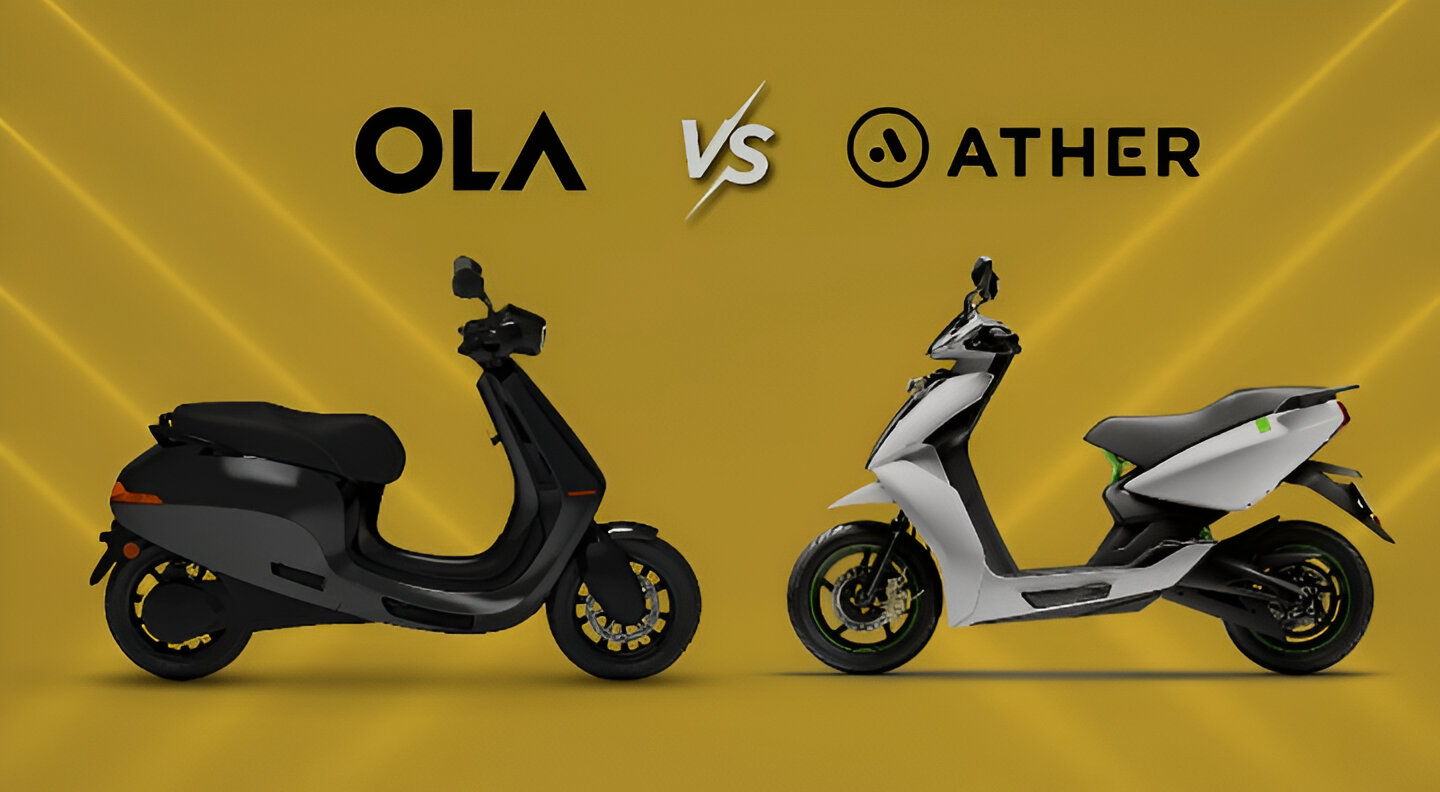Back
Vishu Bheda
•
Medial • 8m
𝗢𝗹𝗮 𝗘𝗹𝗲𝗰𝘁𝗿𝗶𝗰 𝘃𝘀. 𝗔𝘁𝗵𝗲𝗿 – 𝗧𝗵𝗲 𝗘𝗩 𝗧𝘄𝗼-𝗪𝗵𝗲𝗲𝗹𝗲𝗿 𝗪𝗮𝗿 𝐈𝐧𝐝𝐢𝐚’𝐬 𝐄𝐕 𝐁𝐨𝐨𝐦: 𝐓𝐡𝐞 𝐑𝐚𝐜𝐞 𝐟𝐨𝐫 𝐃𝐨𝐦𝐢𝐧𝐚𝐧𝐜𝐞 By the 2020s, India was ready for an electric revolution. • Rising fuel prices made EVs a smart choice. • Government subsidies made them affordable. • People wanted greener, smarter transport. And in the two-wheeler space, two names stood out: 🔹𝐀𝐭𝐡𝐞𝐫 𝐄𝐧𝐞𝐫𝐠𝐲 – The careful builder. 🔸𝐎𝐥𝐚 𝐄𝐥𝐞𝐜𝐭𝐫𝐢𝐜 – The aggressive disruptor. Both had big ambitions. But in the long run, 𝐰𝐡𝐨’𝐬 𝐚𝐜𝐭𝐮𝐚𝐥𝐥𝐲 𝐰𝐢𝐧𝐧𝐢𝐧𝐠? 𝗥𝗼𝘂𝗻𝗱 𝟭: 𝗦𝘁𝗿𝗮𝘁𝗲𝗴𝘆 – 𝗦𝘁𝗲𝗮𝗱𝘆 𝗚𝗿𝗼𝘄𝘁𝗵 𝘃𝘀. 𝗥𝗮𝗽𝗶𝗱 𝗘𝘅𝗽𝗮𝗻𝘀𝗶𝗼𝗻 🔹 𝐀𝐭𝐡𝐞𝐫 (𝐅𝐨𝐮𝐧𝐝𝐞𝐝: 𝟐𝟎𝟏𝟑) → Took its time, built strong foundations. 🔸𝐎𝐥𝐚 𝐄𝐥𝐞𝐜𝐭𝐫𝐢𝐜 (𝐅𝐨𝐮𝐧𝐝𝐞𝐝: 𝟐𝟎𝟐𝟏) → Entered with a bang, aiming for quick domination. 𝐀𝐭𝐡𝐞𝐫’𝐬 𝐀𝐩𝐩𝐫𝐨𝐚𝐜𝐡: • 𝐁𝐮𝐢𝐥𝐝 𝐚 𝐬𝐨𝐥𝐢𝐝 𝐩𝐫𝐨𝐝𝐮𝐜𝐭 – No compromises on quality. • 𝐒𝐞𝐭 𝐮𝐩 𝐜𝐡𝐚𝐫𝐠𝐢𝐧𝐠 𝐬𝐭𝐚𝐭𝐢𝐨𝐧𝐬 𝐟𝐢𝐫𝐬𝐭 – Solve infrastructure problems before scaling. • 𝐄𝐱𝐩𝐚𝐧𝐝 𝐠𝐫𝐚𝐝𝐮𝐚𝐥𝐥𝐲 – Grow city by city, ensuring great service. 𝗢𝗹𝗮’𝘀 𝗦𝘁𝗿𝗮𝘁𝗲𝗴𝘆: • 𝐒𝐞𝐥𝐥 𝐛𝐢𝐠 𝐟𝐫𝐨𝐦 𝐃𝐚𝐲 𝟏 – Massive pre-orders before production was ready. • 𝐒𝐤𝐢𝐩 𝐝𝐞𝐚𝐥𝐞𝐫𝐬𝐡𝐢𝐩𝐬 – Sell directly to customers, cutting costs. • 𝐆𝐨 𝐚𝐥𝐥-𝐢𝐧 𝐟𝐚𝐬𝐭 – Open a mega-factory, promise the future. 𝐀𝐭𝐡𝐞𝐫 𝐩𝐥𝐚𝐲𝐞𝐝 𝐭𝐡𝐞 𝐥𝐨𝐧𝐠 𝐠𝐚𝐦𝐞. 𝐎𝐥𝐚 𝐰𝐞𝐧𝐭 𝐟𝐨𝐫 𝐚 𝐪𝐮𝐢𝐜𝐤 𝐰𝐢𝐧. 𝗥𝗼𝘂𝗻𝗱 𝟮: 𝗧𝗵𝗲 𝗣𝗿𝗼𝗱𝘂𝗰𝘁 – 𝗤𝘂𝗮𝗹𝗶𝘁𝘆 𝘃𝘀. 𝗛𝘆𝗽𝗲 🔹 𝐀𝐭𝐡𝐞𝐫 𝟒𝟓𝟎𝐗 – Built for performance, premium pricing. 🔸 𝐎𝐥𝐚 𝐒𝟏 & 𝐒𝟏 𝐏𝐫𝐨 – Loaded with features, priced aggressively. 𝗔𝘁𝗵𝗲𝗿’𝘀 𝗦𝘁𝗿𝗲𝗻𝗴𝘁𝗵𝘀: • 𝐓𝐨𝐩 𝐫𝐢𝐝𝐞 𝐪𝐮𝐚𝐥𝐢𝐭𝐲 – Feels premium and well-engineered. • 𝐒𝐚𝐟𝐞, 𝐫𝐞𝐥𝐢𝐚𝐛𝐥𝐞 𝐛𝐚𝐭𝐭𝐞𝐫𝐲 – No fire incidents, well-tested. • 𝐒𝐞𝐚𝐦𝐥𝐞𝐬𝐬 𝐬𝐨𝐟𝐭𝐰𝐚𝐫𝐞 𝐞𝐱𝐩𝐞𝐫𝐢𝐞𝐧𝐜𝐞 – No major bugs, smooth updates. 𝗢𝗹𝗮’𝘀 𝗦𝘁𝗿𝗲𝗻𝗴𝘁𝗵𝘀: • 𝐌𝐨𝐫𝐞 𝐟𝐞𝐚𝐭𝐮𝐫𝐞𝐬 𝐟𝐨𝐫 𝐥𝐞𝐬𝐬 𝐦𝐨𝐧𝐞𝐲 – Bigger battery, higher speed claims. • 𝐌𝐚𝐬𝐬-𝐦𝐚𝐫𝐤𝐞𝐭 𝐚𝐩𝐩𝐞𝐚𝐥 – Designed for everyday users, not just EV enthusiasts. • 𝐁𝐨𝐥𝐝 𝐦𝐚𝐫𝐤𝐞𝐭𝐢𝐧𝐠 – Promises of AI-driven tech, hyper-fast charging. 𝐀𝐭𝐡𝐞𝐫 𝐟𝐨𝐜𝐮𝐬𝐞𝐝 𝐨𝐧 𝐭𝐫𝐮𝐬𝐭. 𝐎𝐥𝐚 𝐟𝐨𝐜𝐮𝐬𝐞𝐝 𝐨𝐧 𝐦𝐚𝐤𝐢𝐧𝐠 𝐡𝐞𝐚𝐝𝐥𝐢𝐧𝐞𝐬. 𝗥𝗼𝘂𝗻𝗱 𝟯: 𝗧𝗵𝗲 𝗥𝗲𝗮𝗹 𝗧𝗲𝘀𝘁 – 𝗖𝘂𝘀𝘁𝗼𝗺𝗲𝗿 𝗘𝘅𝗽𝗲𝗿𝗶𝗲𝗻𝗰𝗲 An EV isn’t just about buying—it’s about living with it. 𝗔𝘁𝗵𝗲𝗿’𝘀 𝗦𝘁𝗿𝗲𝗻𝗴𝘁𝗵𝘀: • 𝐀𝐭𝐡𝐞𝐫 𝐆𝐫𝐢𝐝 𝐜𝐡𝐚𝐫𝐠𝐢𝐧𝐠 𝐧𝐞𝐭𝐰𝐨𝐫𝐤 – Making charging easy. • 𝐆𝐨𝐨𝐝 𝐬𝐞𝐫𝐯𝐢𝐜𝐞 𝐬𝐮𝐩𝐩𝐨𝐫𝐭 – Dealerships handle repairs and maintenance. • 𝐇𝐚𝐩𝐩𝐲 𝐜𝐮𝐬𝐭𝐨𝐦𝐞𝐫𝐬 – Fewer complaints, smoother ownership. 𝗢𝗹𝗮’𝘀 𝗣𝗿𝗼𝗯𝗹𝗲𝗺𝘀: • 𝐃𝐞𝐥𝐚𝐲𝐞𝐝 𝐝𝐞𝐥𝐢𝐯𝐞𝐫𝐢𝐞𝐬 – Many customers waited months. • 𝐒𝐨𝐟𝐭𝐰𝐚𝐫𝐞 𝐠𝐥𝐢𝐭𝐜𝐡𝐞𝐬 – Bugs, overheating, and sudden shutdowns. • 𝐖𝐞𝐚𝐤 𝐚𝐟𝐭𝐞𝐫-𝐬𝐚𝐥𝐞𝐬 𝐬𝐞𝐫𝐯𝐢𝐜𝐞 – No dealerships meant slow and unreliable support. 𝐀𝐭𝐡𝐞𝐫 𝐤𝐞𝐩𝐭 𝐭𝐡𝐢𝐧𝐠𝐬 𝐬𝐦𝐨𝐨𝐭𝐡. 𝐎𝐥𝐚 𝐬𝐭𝐫𝐮𝐠𝐠𝐥𝐞𝐝 𝐰𝐢𝐭𝐡 𝐠𝐫𝐨𝐰𝐢𝐧𝐠 𝐩𝐚𝐢𝐧𝐬. 𝗥𝗼𝘂𝗻𝗱 𝟰: 𝗠𝗮𝗿𝗸𝗲𝘁 𝗥𝗲𝗮𝗹𝗶𝘁𝘆 – 𝗪𝗵𝗼’𝘀 𝗧𝗵𝗿𝗶𝘃𝗶𝗻𝗴? By 2024, the picture became clear. • 𝐀𝐭𝐡𝐞𝐫 𝐤𝐞𝐩𝐭 𝐠𝐫𝐨𝐰𝐢𝐧𝐠 – Launched better models, expanded charging stations. • 𝐎𝐥𝐚 𝐟𝐚𝐜𝐞𝐝 𝐛𝐚𝐜𝐤𝐥𝐚𝐬𝐡 – Quality issues, unhappy customers, and fire-related incidents. • 𝐀𝐭𝐡𝐞𝐫 𝐩𝐥𝐚𝐲𝐞𝐝 𝐢𝐭 𝐬𝐚𝐟𝐞 – Ola took risks that sometimes backfired. 𝗙𝗶𝗻𝗮𝗹 𝗩𝗲𝗿𝗱𝗶𝗰𝘁: 𝗪𝗵𝗼’𝘀 𝗪𝗶𝗻𝗻𝗶𝗻𝗴? 𝐀𝐭𝐡𝐞𝐫 𝐄𝐧𝐞𝐫𝐠𝐲 → The 𝐭𝐫𝐮𝐬𝐭𝐞𝐝 𝐩𝐫𝐞𝐦𝐢𝐮𝐦 𝐜𝐡𝐨𝐢𝐜𝐞, growing steadily. 𝐎𝐥𝐚 𝐄𝐥𝐞𝐜𝐭𝐫𝐢𝐜 → The 𝐦𝐚𝐬𝐬-𝐦𝐚𝐫𝐤𝐞𝐭 𝐝𝐢𝐬𝐫𝐮𝐩𝐭𝐨𝐫, still fixing early mistakes. Ola sold 𝐦𝐨𝐫𝐞 𝐬𝐜𝐨𝐨𝐭𝐞𝐫𝐬, but Ather built 𝐦𝐨𝐫𝐞 𝐭𝐫𝐮𝐬𝐭. 𝐀𝐭𝐡𝐞𝐫 𝐩𝐥𝐚𝐲𝐞𝐝 𝐬𝐦𝐚𝐫𝐭. 𝐎𝐥𝐚 𝐩𝐥𝐚𝐲𝐞𝐝 𝐟𝐚𝐬𝐭. But in India’s EV race, 𝐨𝐧𝐥𝐲 𝐨𝐧𝐞 𝐬𝐭𝐫𝐚𝐭𝐞𝐠𝐲 𝐰𝐢𝐥𝐥 𝐰𝐢𝐧 𝐢𝐧 𝐭𝐡𝐞 𝐞𝐧𝐝. 𝐖𝐡𝐨 𝐝𝐨 𝐲𝐨𝐮 𝐭𝐡𝐢𝐧𝐤 𝐢𝐬 𝐥𝐞𝐚𝐝𝐢𝐧𝐠? I hope you've found this helpful. Follow Vishu Bheda for more such startups wars!

Replies (5)
Download the medial app to read full posts, comements and news.


























